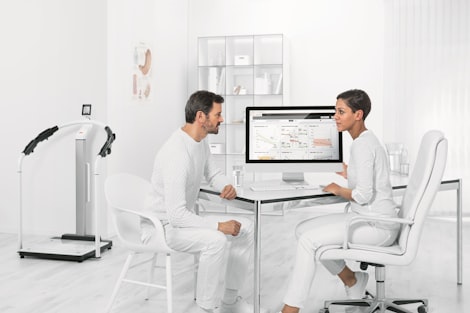As the healthcare industry continues to embrace technology, virtual desktop infrastructure (VDI) has become an increasingly popular solution for managing IT infrastructure. VDI offers healthcare organizations the ability to streamline their IT management while improving security, flexibility, and cost efficiency.
In this article, we will provide an introduction to VDI for healthcare, explain how it works, its benefits, implementation considerations, challenges and considerations, and real-world examples.
What is VDI?
In simple terms, VDI is a technology that allows users to access their desktop environment from a remote location. With VDI, the desktop environment is hosted on a server and accessed by users through a client device, such as a laptop, tablet, or smartphone. Users can access their desktop environment from anywhere with an internet connection, which provides a level of flexibility and mobility that is essential for healthcare providers.
Benefits of VDI in Healthcare
There are several benefits of VDI in healthcare, including improved security and compliance, increased flexibility and mobility, enhanced collaboration and communication, and cost savings and efficiency improvements.
Improved Security and Compliance
One of the biggest concerns for healthcare providers is the security of patient data. VDI provides a secure way to manage data by hosting the desktop environment on a central server, which reduces the risk of data breaches and cyberattacks. VDI can also help healthcare organizations comply with regulations such as HIPAA, which require strict security protocols for patient data.
Increased Flexibility and Mobility
VDI allows healthcare providers to access their desktop environment from any location with an internet connection, which provides a level of flexibility and mobility that is essential for healthcare providers. This is especially useful for healthcare providers who need to access patient data from multiple locations, such as hospital rooms, clinics, or home offices.
Enhanced Collaboration and Communication
VDI enables healthcare providers to collaborate and communicate more efficiently by providing a centralized desktop environment that can be accessed from any location. This can improve productivity and communication among healthcare providers, which can ultimately improve patient care.
Cost Savings and Efficiency Improvements
VDI can provide significant cost savings for healthcare organizations by reducing the need for expensive hardware and software. With VDI, the desktop environment is hosted on a central server, which reduces the need for individual workstations. This can result in lower hardware costs, energy costs, and maintenance costs. VDI can also improve efficiency by reducing the time and resources required to manage individual workstations.
VDI Implementation in Healthcare
Implementing VDI in healthcare requires careful consideration of several factors, including the technical requirements, regulatory compliance, and cost. Healthcare organizations must also determine which VDI solution is best suited for their specific needs.
Considerations When Implementing VDI
There are several factors to consider when implementing VDI in healthcare, including the number of users, the required hardware, and the network bandwidth. Healthcare organizations must also consider the level of technical expertise required to manage the VDI solution.
Common VDI Solutions Used in Healthcare
There are several VDI solutions that are commonly used in healthcare, including Citrix, VMware, and Microsoft. Each of these solutions has its strengths and weaknesses, and healthcare organizations must determine which solution is best suited for their specific needs.
VDI Use Cases in Healthcare
VDI has several use cases in healthcare, including remote access to patient data, telehealth, and medical education. For example, VDI can provide healthcare providers with remote access to patient data, which can improve patient care by enabling providers to access patient data from any location. VDI can also be used for telehealth, which allows patients to access healthcare services remotely.
Challenges and Considerations
Implementing VDI in healthcare can be challenging, and healthcare organizations must carefully considerWhen it comes to healthcare, VDI offers a number of benefits over traditional desktop computing. For starters, VDI enables healthcare professionals to access patient data from anywhere, at any time, as long as they have an internet connection. This means that doctors and nurses can consult with patients and colleagues, review test results and medical histories, and even prescribe medication without being physically present in the hospital or clinic.
Moreover, VDI offers a level of security and control that is difficult to achieve with traditional desktop computing. With VDI, all data is stored in a centralized location and can be easily backed up and restored in the event of a system failure or disaster. Additionally, VDI allows administrators to easily control user access and permissions, ensuring that only authorized personnel can access sensitive patient information.
Another benefit of VDI is the ability to quickly provision new virtual desktops as needed, which can be especially useful during peak usage times or in emergency situations. This means that healthcare organizations can scale their computing resources up or down as needed, without having to worry about buying and deploying new hardware.
Of course, there are some potential downsides to VDI as well. For one thing, VDI can be more complex and expensive to set up and maintain than traditional desktop computing. Additionally, VDI requires a reliable and fast internet connection, which may not always be available in certain regions or in the event of a network outage.
Despite these challenges, VDI remains a popular and effective solution for healthcare organizations looking to improve their computing infrastructure. By providing secure and reliable access to patient data from anywhere, VDI can help healthcare professionals provide better care to their patients and improve overall healthcare outcomes.
How Anteris Can Help
Anteris Virtual Desktop Infrastructure (VDI) uses our enterprise-grade private cloud to provide remote computing. Information is stored on the cloud instead of the devices your team is using. That means you and your team can access the data and programs you need from any location around the globe.
Learn more about how Anteris can help you.



